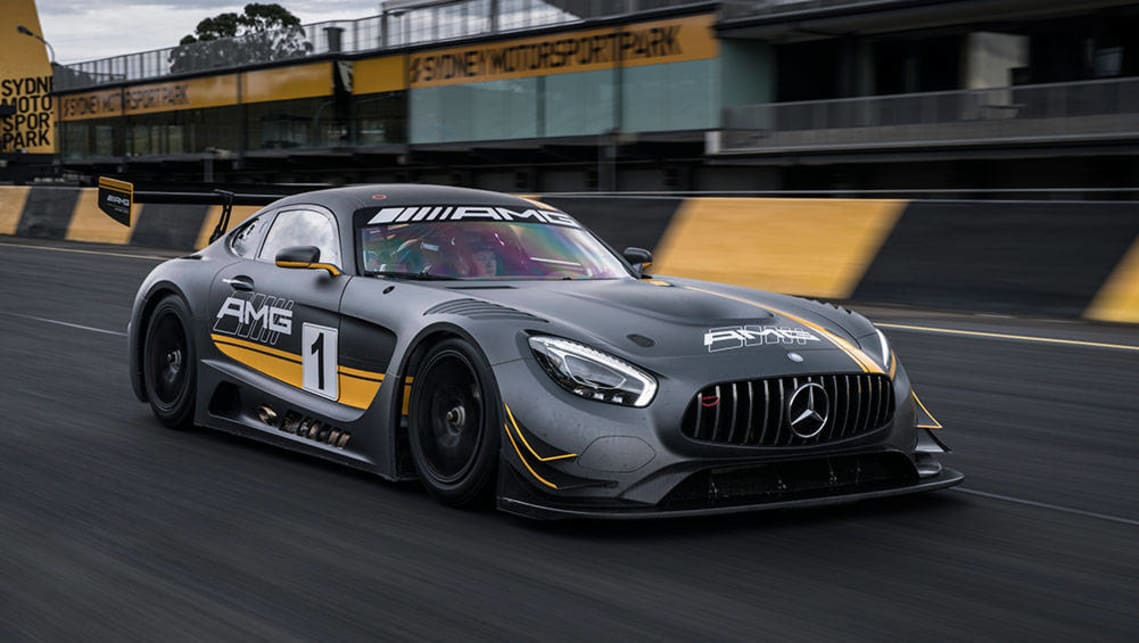
Isuzu MU-X LS-T 2024 review: snapshot
The LS-T is the flagship the 2024 MU-X range, offered exclusively with the...
Browse over 9,000 car reviews

I have finally figured out why the world’s best race drivers are rake thin.
Inside the cabin is as hot as a sauna - but they wear triple layer fireproof race suits.
They also need to be tiny to squeeze into the damn things and navigate their way over roll cage.
Their boney backsides sit in a plastic seat with no padding. And the steering wheel isn’t so much as a small piece of metal with a handle at each end. It saves space, because otherwise you would hit your knees.
I learned this after getting the chance to clamber behind the wheel of the new Mercedes GT3 race car, one of only two in Australia, 16 in the world and priced at a neat $1 million.
Incredibly, Mercedes handed the keys - figuratively speaking, there is no key or lock for this $1 million car - to a handful of motoring hacks at Sydney Motorsport Park this week.
“Oh and please don’t crash it,” says the instructor. “We’re racing this exact car in 10 days from now.”
No pressure then.
Because the Mercedes GT3 is so low to the ground, has bigger wings than V8 Supercars and a more powerful engine, it can lap this circuit five seconds quicker than our fastest Holden and Ford heroes.
Five seconds doesn’t sound like much, but keep in mind most of the Top 10 V8 Supercars are within 0.3 second of each other. So five seconds is the equivalent of a decade in race car terms.
Acceleration is so brutal it slams your helmet back into the seat.
The only thing this car has in common with its road-going cousin are the headlights and tail-lights.
The roof has an access hole; it’s not big enough for a driver to crawl through but it is wide enough for a paramedic to reach in and treat the driver after a crash. Talk about a sobering thought. I was already nervous enough.
Oh, and it’s left hand drive - and there’s only enough room to brake with your left foot, accelerate with your right.
Let the clutch out abruptly on take-off, but then don’t touch it the rest of the time; the car will do the rest.
And with that quick tutorial and a Bluetooth headset in my ear - to listen to the bravest man in the world, my instructor - we were off for three laps. The mission: keep it shiny side up.
The acceleration is so brutal it slams your helmet back into the seat. The force was strong enough that the Bluetooth headset switched off with each gear change. I learned to crane my head forward, and steer with one hand while reactivating the headset. Excellent.
The steering was sharper than a computer mouse on its most sensitive setting. A slight turn amounted almost to a U-turn.
The brakes squeal, not in pain but with sheer force. They’re almost as impressive as the acceleration.
Unsurprisingly, there were no contract signings on offer at the end of the test drive
I never got anywhere near reaching the limit of the sticky slick tyres; it felt they were made of Velcro.
Not wanting to tempt fate, but it would have been hard to crash it. There are 12 settings for the anti-lock brakes and traction control, from wet to dry and everywhere in between.
This car is so easy to drive (although hard to see out of) that mere mortals are getting behind the wheel.
If you’re rich enough ($1 million for the car and another $800,000 for a season of racing) you too can be a pretend race driver.
Some of that cost is to hire staff to help you climb out of the claustrophobic cabin; it took three crew to extricate me.
Unsurprisingly, there were no contract signings on offer at the end of the test drive, which cost the equivalent of $100 per kilometre.
But there are two great feelings driving exotic supercars like this. The first one is getting behind the wheel, but the best one is handing it back in one piece. You and the car.
Comments